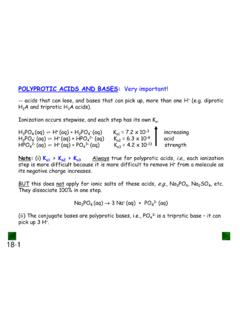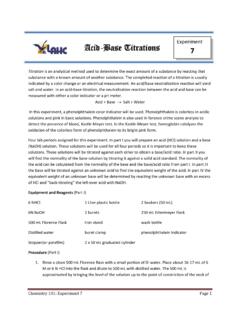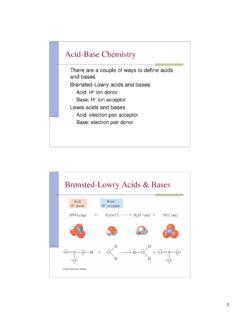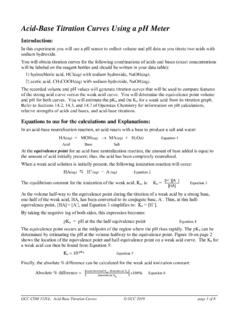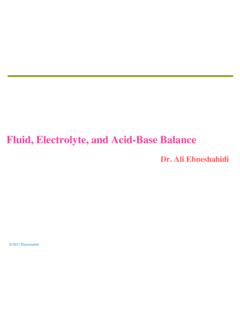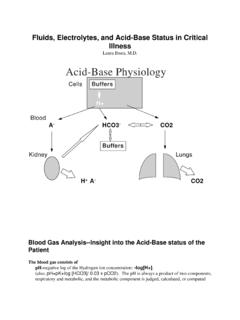Transcription of Section 19.1. Acid-Base Buffer Solutions
1 19-1 Section Acid-Base Buffer SolutionsIn everyday English, a Buffer is something that lessens the impact of an externalforce.** An Acid-Base Buffer is a solution that lessens the change in[H3O+] that would result when a strong acid or base is added **A Buffer is a concentrated solution of a weak acid (or base ), together with a saltcontaining the conjugate base (or acid ).How does a Buffer work? The Common-Ion Effect(example of Le Chatelier s Principle)= the shift in an equilibrium caused by the addition (or removal) of one of thespecies participating in the :addition of sodium acetate (CH3 COONa or NaAc) to acetic acid (CH3 COOHor HAc) solutionCH3 COOH (aq) + H2O(l) CH3 COO-(aq) + H3O+(aq)acetic acid (HAc)acetate ion (Ac-)if we add CH3 COO-SHIFTNet Effect: [H3O+] decreases pH increasesAlso, [OH-] increases pOH ,a weak acid and its conjugate baseor a weak base and its conjugate.
2 Addition of NH4Cl to (aq) + H2O (l) NH4+(aq) + OH-(aq)if we add NH4+Net Effect:[OH-] decreases, pOH increases[H3O+] increases, pH decreases19-3 New type of problem to solve! Solutions with two things dissolvedExample:Calculate[H3O+] in a solution that is M in HF and M in NaF. Alsocalculate % :UseHF(aq) H+(aq) + F-(aq) ? or F-(aq) + H2O(l) HF (aq) + OH-(aq) ?Answer: Since both include HF, F-,H+,OH-(the last two are related by[H+][OH-]=1x10-14), we can use either equation !!HF (aq) H+(aq) + F-(aq)[init] M[change] -x+x+x[equil]( )x( + x)Ka== x = ( ) ( x 10-4) = x 10-4M(x<< ) [H+]=[H3O+]= :in pure M HF, [H3O+]= pure M NaF, [H3O+]= ionization of HF = ([H+]/[HF]) 100% = ( x 10-4) 100% = :For pure M HF, % ionization is the presence of NaF in the solution has decreased the % ionization of HF(equilibrium shifted to the left) less [H3O+] less acidic.
3 [HF]]][F[H- x)-( ) x( , let s go back and see how a Buffer works:It is a solutioncontaining high concentrations of a weak acid ( base ) and its conjugate base ( acid ).CH3 COOH (aq) H+ (aq) + CH3 COO-(aq) acetic acid (HAc) acetate ion (Ac-)If strong acid added:H++Ac- HA(K>>1 assume rxn goes ~100%)If strong base added:OH-+HA H2O+Ac-(K>>1 assume rxn goes ~100%)Reactions go strongly to right [H+]and[OH-] in the solution change logic for weak base ( ,NH3)andsalt( ,NH4+Cl-).** As long as not too much strong acid or base is added, it will be mopped-up by the Buffer and pH will change only slightly **Figure of pH on addition of strong acid or of [HA]/[A-] on addition of strong acid or and effect of adding acid or base to an effect of adding acid or base to a a Buffer has equal concentrations of A-and + Buffer has more HA after addition of H3O+.
4 H2O + CH3 COOH H3O++ CH3 COO-OH- Buffer has more A-after addition of + OH- CH3 COO-+ H2O19-7 Buffer Calculations:Two types we must be able to handle:(A) Calculate the pH (or pOH, [H3O+], [OH-]) of a Buffer solution(B) Calculate new pH (or pOH, ..) after something is addedExample: Sample Problem (1)Calculate pH of a solution that is M HAc and M (aq) H+(aq)+ Ac-(aq)[init] M[change] -x+x+x[equil]( )x( +x)Ka= =x= [H3O+] = x 10-5M pH = )x( (2) What is the new pH after mol of solid NaOH is dissolved in Lof the Buffer solution?
5 [NaOH] = = mol/L = MNaOH is a strong base dissociates 100% [OH-] = MWhat will happen when we add the NaOH? All the added OH-will react with HAc togive more Ac-. Keep track of changes with a table:HAc (aq) + OH-(aq) Ac-(aq) + H2O (aq)[init] M[addition]+ M[equil] M new [HAc] = M , new [Ac-] = MNow calculate new pHHAc (aq) H+ (aq) + Ac-(aq)[init] M[change]-x+x+x[equil]( )x( +x)Ka= = = (assumption okay) [H3O+] = x 10-5M pH = pH changed only slightly BUFFERS WORK!!L )x( (3) What is the new pH if mol HCl had been added to (1) (instead mol NaOH)?
6 [HCl] = M [H3O+] = M (100% dissociation)What will happen when we add the H+(= H3O+)?AllofitwillreactwithAc-to give moreHAc. Keep track of changes with a table:Ac-(aq) + H3O+ (aq) HAc (aq) + H2O (l)[init] M[addition] M[equil] MNew [HAc] = M New [Ac-] = MNow calculate new pHHAc (aq) H+ (aq) + Ac-(aq)[init] +x+x[equil]( )x( )Ka= = x = ( )( x 10-5) = x 10-5M [H3O+]= pH = , the pH has changed only slightly, even though a significantamount of strong acid was added. BUFFERS WORK!!x)-( )-x( Equation** This allows us to calculate the pH without calculating [H+]first!
7 **It can be shown for a solution of a weak acid HA that the pH, [HA] and [A-], andthe pKaof the acid are related bypH = pKa+ logor, for any weak acid /conjugate base , or weak base /conjugate acidpH = pKa+ logLet s apply H-H eqn. to our sample problem :pKa= -log ( x 10-5) = (1) pH = pKa+log= +log pH = (since log 1 = 0)(2) pH = + log= pH = (3) pH = + log= pH = methods give same answers (within rounding errors on sig. figs.) [HA]][A- [ acid ][ base ][HAc]][Ac- also involving volume changes:(extra complication to deal with)Example:A Buffer is prepared from mL of M NH3and mL of What is the pH of the Buffer solution?
8 Kb= :The Buffer involves the NH3/NH4+conjugate acid / base (aq) + H2O (l) NH4+ (aq) + OH-(aq)Conc s: Since two Solutions are mixed, both have been this: ViMi=VfMfVf= mL + mL = mL[NH3]f=ViMi/Vf= ( mL)( M) mL = M[NH4+]f=ViMi/Vf= ( mL)( M) mL = MNow, we can calculate pH:NH3(aq) + H2O (l) NH4+(aq) + OH-(aq)[init] [change] -x+x+x[equil]( )( +x)xKb= x= = pOH = -log ( x 10-5) = pH = we now add strong acid or base , we would again have to calculate new totalvolume and new [NH3]and[NH4+] and [ acid or base ] to calculate new )-( )x( Capacity and Buffer Range(A) Buffer Capacityishowmuchaddedacidorbaseabuffers olutioncan mopup before it can no longer resist changes in the pH.
9 ** The more concentrated the components of the Buffer , the greater the Buffer capacity **.Thus, a Buffer containing M NH3 M NH4+is good, but a Buffer containing M NH4+is much :Since [NH3]/[NH4+] is 1 in both cases, they both have pH = , but verydifferent Buffer , the more similar the conc s of the two components, the higher is the buffercapacity. The greater the difference, the greater will be the pH change when strongacid or base is added.** Buffer capacity highest when [HA] = [A-]**From the H-H eqn: pH = pKa+ log when [A-] = [HA], log = log 1 = 0 pH = pKagives the highest Buffer capacity** Summarizing: Buffer capacity is highest when:(1) [HA] and [A-] are large(2) [HA] = [A-](3) The pH is equal to (or very near) the pKaof the HA used.
10 **[HA]][A-[HA]][A-19-13 Figure relation between Buffer capacity and pH strong base is added, the pH increases least for the most concentrated graph shows the final pH values for four different Buffer Solutions after the addition of strong :Which is the best acid to use to make a Buffer solution with a pH = Acetic acid (pKa= );chlorousacid(pKa= ) or formic acid (pKa= ).To ensure high capacity, we need [HA] [A-]. It is possible to get this andhave a pH = only if we use chlorous acid since its pKais close to the targetpH we need.
